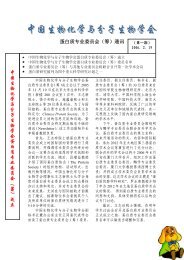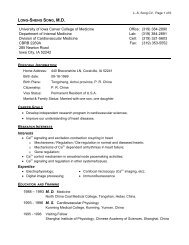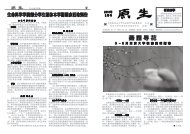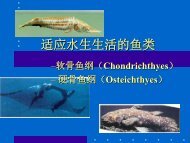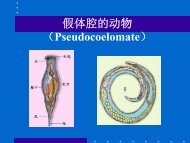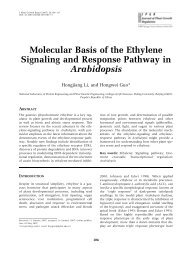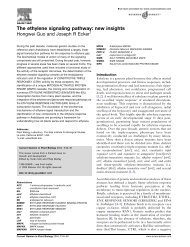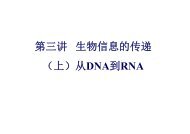Derepression of ethylene-stabilized transcription factors (EIN3/EIL1 ...
Derepression of ethylene-stabilized transcription factors (EIN3/EIL1 ...
Derepression of ethylene-stabilized transcription factors (EIN3/EIL1 ...
Create successful ePaper yourself
Turn your PDF publications into a flip-book with our unique Google optimized e-Paper software.
<strong>Derepression</strong> <strong>of</strong> <strong>ethylene</strong>-<strong>stabilized</strong> <strong>transcription</strong><strong>factors</strong> (<strong>EIN3</strong>/<strong>EIL1</strong>) mediates jasmonate and<strong>ethylene</strong> signaling synergy in ArabidopsisZiqiang Zhu a,1 , Fengying An a,1 , Ying Feng a , Pengpeng Li a,2 , Li Xue b ,MuA a , Zhiqiang Jiang a , Jong-Myong Kim c ,Taiko Kim To c , Wei Li b , Xinyan Zhang a , Qiang Yu a , Zhi Dong a , Wen-Qian Chen a , Motoaki Seki c , Jian-Min Zhou b ,and Hongwei Guo a,3a State Key Laboratory <strong>of</strong> Protein and Plant Gene Research, College <strong>of</strong> Life Sciences, Peking University, Beijing 100871, China; b National Institute <strong>of</strong> BiologicalSciences, Beijing 102206, China; and c RIKEN Plant Science Center, Yokohama 2300045, JapanEdited by Mark Estelle, University <strong>of</strong> California at San Diego, La Jolla, CA, and approved June 9, 2011 (received for review March 11, 2011)Jasmonate (JA) and <strong>ethylene</strong> (ET) are two major plant hormonesthat synergistically regulate plant development and tolerance tonecrotrophic fungi. Both JA and ET induce the expression <strong>of</strong>several pathogenesis-related genes, while blocking either signalingpathway abolishes the induction <strong>of</strong> these genes by JA and ETalone or in combination. However, the molecular basis <strong>of</strong> JA/ETcoaction and signaling interdependency is largely unknown. Here,we report that two Arabidopsis ET-<strong>stabilized</strong> <strong>transcription</strong> <strong>factors</strong>(<strong>EIN3</strong> and <strong>EIL1</strong>) integrate ET and JA signaling in the regulation <strong>of</strong>gene expression, root development, and necrotrophic pathogendefense. Further studies reveal that JA enhances the <strong>transcription</strong>alactivity <strong>of</strong> <strong>EIN3</strong>/<strong>EIL1</strong> by removal <strong>of</strong> JA-Zim domain (JAZ)proteins, which physically interact with and repress <strong>EIN3</strong>/<strong>EIL1</strong>. Inaddition, we find that JAZ proteins recruit an RPD3-type histonedeacetylase (HDA6) as a corepressor that modulates histone acetylation,represses <strong>EIN3</strong>/<strong>EIL1</strong>-dependent <strong>transcription</strong>, and inhibitsJA signaling. Our studies identify <strong>EIN3</strong>/<strong>EIL1</strong> as a key integrationnode whose activation requires both JA and ET signaling, andillustrate <strong>transcription</strong>al derepression as a common mechanismto integrate diverse signaling pathways in the regulation <strong>of</strong> plantdevelopment and defense.root hair | Botrytis cinereaPlants are sessile organisms and face different environmentalchanges during their lifespan. To survive various abiotic andbiotic stresses, plants synthesize a number <strong>of</strong> small moleculesfunctioning as phytohormones to elaborately regulate their growth,development, and defense. Two types <strong>of</strong> phytohormones—<strong>ethylene</strong> (ET) and jasmonate (JA)—are crucial for plant developmentand defense against necrotrophic fungi infections (1–3). Complicated modes <strong>of</strong> interaction between ET and JA havebeen documented in different processes. For example, ETstrongly suppresses JA-induced wounding-responsive gene expression,but JA suppresses ET-induced apical hook formation(4, 5), indicative <strong>of</strong> their antagonisms. Upon necrotrophic fungiinfections, plants can quickly produce ET and JA and induce theexpression <strong>of</strong> downstream defense genes (like ERF1, ORA59,and PDF1.2) that help plants tolerate or fight against the fungalpathogens (1). Plants treated with exogenous JA or ET expresshigh levels <strong>of</strong> defense genes (6, 7), and simultaneous treatmentwith JA and ET results in the highest expression (8). Nevertheless,in the ET or JA insensitive mutant (ein2 or coi1, respectively),JA and ET alone or in combination fail to induce theexpression <strong>of</strong> those defense genes (8, 9), indicating that the twohormone-signaling pathways are required concomitantly for theactivation <strong>of</strong> plant-defense response. These results suggest thatJA and ET act synergistically and mutually dependently in regulatingnecrotrophic pathogen responses. However, the moleculardetails underlying such hormone synergy and signalinginterdependency are currently unknown.ET is a gaseous hormone, which is perceived by its receptorsand represses a Raf-like kinase CONSTITUTIVE ETHYL-ENE RESPONSE 1 (CTR1) (10, 11). Downstream <strong>of</strong> CTR1 isETHYLENE INSENSITIVE 2 (EIN2), which is an essentialpositive regulator in ET signaling (12). ETHYLENE IN-SENSITIVE 3 (<strong>EIN3</strong>) and its closest homolog <strong>EIN3</strong>-LIKE 1(<strong>EIL1</strong>) are two primary <strong>transcription</strong> <strong>factors</strong> downstream <strong>of</strong>EIN2 (6, 7, 13), which are necessary and sufficient for the induction<strong>of</strong> the vast majority <strong>of</strong> <strong>ethylene</strong> response genes (13–15).In the absence <strong>of</strong> ET, <strong>EIN3</strong>/<strong>EIL1</strong> are quickly degraded throughthe action <strong>of</strong> two <strong>EIN3</strong>-binding F-box proteins 1 and 2 (EBF1and EBF2), and ET enhances <strong>EIN3</strong>/<strong>EIL1</strong> accumulation, probablythrough the repression <strong>of</strong> EBF1/2 (14, 16–18).JA is synthesized and conjugated with isoleucine to form theactive hormone JA-Ile (19, 20), which is perceived by its receptorCORONATINE INSENSITIVE 1 (COI1), an F-box protein(21–25). JASMONATE ZIM-DOMAIN (JAZ) proteins are<strong>transcription</strong>al repressors, which interact with MYC2 <strong>transcription</strong>factor and repress its function (23, 26, 27). Recently, onepossible mechanism underlying JAZ repression on MYC2 hasbeen demonstrated in that JAZ proteins associate with NOVELINTERACTOR <strong>of</strong> JAZ (NINJA) to recruit TOPLESS as a corepressorto fulfill this function (28). The perception <strong>of</strong> JA-Ileinduces the interaction between COI1 and JAZs, which bringsJAZs for degradation and relieves their repression on MYC2(23, 26). Two MYC2-like bHLH proteins (MYC3 and MYC4)were also able to interact with JAZs and act addictively withMYC2 in mediating a subset <strong>of</strong> JA-regulated responses, includinginhibition <strong>of</strong> root elongation, wound response, and metabolism(29–31). Besides MYC2/MYC3/MYC4, two MYB <strong>transcription</strong><strong>factors</strong> (MYB21 and MYB24) were recently identified as JAZtargets in regulating plant stamen development (32).Histone deacetylation, which is catalyzed by histone deacetylases(HDAs), is a type <strong>of</strong> chromatin modification commonlyassociated with <strong>transcription</strong>al repression (33). It has beenreported that histone deacetylation affects many growth anddevelopmental events in plants, such as flowering time, coldtolerance, embryogenesis, root hair development, abscisic acid,and salt responses (34–38). A molecular link between this epigeneticcontrol and JA signaling has been implied, as an RPD3-type histone deacetylase 6 (HDA6) was reported to associatewith COI1 in a coimmunoprecipitation (co-IP) assay (39). It wasalso found that the transcript levels <strong>of</strong> some JA-responsive genesare altered in HDA6 or HDA19 loss-<strong>of</strong>-function mutants andAuthor contributions: Z.Z. and H.G. designed research; Z.Z., F.A., Y.F., P.L., L.X., M.A., W.L.,X.Z., Q.Y., and Z.D. performed research; J.-M.K., T.K.T., W.-Q.C., and M.S. contributed newreagents/analytic tools; Z.Z., Z.J., J.-M.Z., and H.G. analyzed data; and Z.Z. and H.G. wrotethe paper.The authors declare no conflict <strong>of</strong> interest.This article is a PNAS Direct Submission.1 Z.Z. and F.A. contributed equally to this work.2 Present address: Department <strong>of</strong> Biology, Stanford University, Stanford, CA 94305.3 To whom correspondence should be addressed. E-mail: hongweig@pku.edu.cn.This article contains supporting information online at www.pnas.org/lookup/suppl/doi:10.1073/pnas.1103959108/-/DCSupplemental.PLANT BIOLOGYwww.pnas.org/cgi/doi/10.1073/pnas.1103959108 PNAS Early Edition | 1<strong>of</strong>6
transgenic overexpression plants (40, 41). However, the action <strong>of</strong>these HDAs in JA signaling is not clear.Here, we report that <strong>EIN3</strong> and <strong>EIL1</strong> integrate ET and JAsignaling in plant development and defense against necrotrophicpathogens. JAZ proteins directly interact with <strong>EIN3</strong>/<strong>EIL1</strong> andrecruit HDA6 as a corepressor to repress the <strong>transcription</strong>al activity<strong>of</strong> <strong>EIN3</strong>/<strong>EIL1</strong>. Our work defines <strong>EIN3</strong>/<strong>EIL1</strong> as a previouslyunexplored class <strong>of</strong> JAZ-associated <strong>transcription</strong> <strong>factors</strong> that aresubject to JAZ repression via the action <strong>of</strong> histone deacetylation,and provides unique insights into how plant hormones coordinatelyregulate plant development and defense response.Results<strong>EIN3</strong>/<strong>EIL1</strong> Are Positive Regulators Mediating a Subset <strong>of</strong> JA Responses.Previous studies have revealed that JA alone or in combinationwith ET fails to induce pathogenesis-related genes (such asERF1, ORA59, PDF1.2) inein2 background (8, 9). Because ein3eil1 is phenotypically similar to ein2 and one <strong>of</strong> ET/JA-regulatedgenes (ERF1) is a direct target <strong>of</strong> <strong>EIN3</strong> (7, 13), we hypothesizedthat <strong>EIN3</strong> and <strong>EIL1</strong> may function as key <strong>transcription</strong>al regulators<strong>of</strong> JA/ET-induced gene expression. We first examined theinduction <strong>of</strong> JA-responsive genes in ein3 eil1 upon JA treatment.The JA induction <strong>of</strong> pathogenesis-related genes (ERF1, ORA59,and PDF1.2) was abolished in ein3 eil1, but the expression <strong>of</strong>wound-response genes (e.g., VSP2) that are regulated by MYC2was still induced (Fig. 1A). ein3 eil1 was also insensitive to thecombination <strong>of</strong> JA and ET treatments in terms <strong>of</strong> ERF1 induction(Fig. S1A). Because the expression <strong>of</strong> pathogenesisrelatedgenes is correlated with plant tolerance to necrotrophicfungi (42), we tested plant response to Botrytis cinerea infection.Our result showed that plants lacking <strong>EIN3</strong>, <strong>EIN3</strong>/<strong>EIL1</strong>, orEIN2 were more susceptible to B. cinerea, whereas myc2 wasmore tolerant to the fungus (Fig. 1B and Fig. S1 B and C) (13).Next, we sought to determine whether loss <strong>of</strong> <strong>EIN3</strong>/<strong>EIL1</strong>affects other JA-regulated responses. JA has been reported toinduce root hair development (43). However, such induction inein3 eil1 was largely abolished (Fig. 1 C and D). We also foundthat ein3 eil1 was partially insensitive in JA-induced inhibition <strong>of</strong>root elongation (Fig. 1E). Conversely, transgenic plants overexpressing<strong>EIN3</strong> or <strong>EIL1</strong> (<strong>EIN3</strong>ox or <strong>EIL1</strong>ox) (6) were hypersensitiveto JA in root-growth inhibition (Fig. 1F). On the otherhand, ein3 eil1 was indistinguishable from WT in terms <strong>of</strong> fertilityand JA-induced anthocyanin biosynthesis (Fig. S2). Collectively,we conclude that <strong>EIN3</strong> and <strong>EIL1</strong> are positive regulators <strong>of</strong>a subset <strong>of</strong> JA responses, including pathogenesis-related geneexpression, plant resistance to necrotrophic fungi, and root development,but not fertility and pigment metabolism.JAZ Proteins Interact with <strong>EIN3</strong>/<strong>EIL1</strong>. To understand how <strong>EIN3</strong>/<strong>EIL1</strong> mediate JA signaling, we speculated that <strong>EIN3</strong> and <strong>EIL1</strong>might be targeted by JAZ proteins, and thus tested the interactionbetween JAZ proteins and <strong>EIN3</strong>/<strong>EIL1</strong>. We found thatJAZ1 interacted with <strong>EIN3</strong> in yeast cells, and an <strong>EIN3</strong> fragmentcontaining amino acid residues 200 to 500 was sufficient forJAZ1 binding (Fig. 2A). The interaction between JAZ1 and an<strong>EIL1</strong> fragment (amino acids 201–501) was also observed (Fig.S3A). To test if <strong>EIN3</strong>/<strong>EIL1</strong> interacts with other JAZ proteins, wechose JAZ3 and JAZ9 and found that both JAZ3 and JAZ9were able to interact with <strong>EIN3</strong> (amino acids 200–500) and <strong>EIL1</strong>(amino acids 201–501) in yeast cells (Fig. S3B). A pull-downassay also verified JAZ1-<strong>EIN3</strong> interaction in which Escherichiacoli-expressed GST-JAZ1 successfully pulled down <strong>EIN3</strong> fromplant total protein extracts (Fig. 2B). To confirm JAZ1-<strong>EIN3</strong>interaction in vivo, we performed a co-IP assay in the 35S:JAZ1-GUS transgenic plants (23) and found that the anti-GUS antibodywas able to precipitate <strong>EIN3</strong> along with JAZ1-GUS, indicatingtheir association in planta (Fig. 2C). A bimolecularfluorescence complementation (BiFC) assay in onion epidermiscells also confirmed JAZ1-<strong>EIN3</strong> interaction in vivo (Fig. 2D). T<strong>of</strong>urther characterize the interaction domain in JAZ1, we used anFig. 1. <strong>EIN3</strong> and <strong>EIL1</strong> are positive regulators <strong>of</strong> JA signaling.(A) Analysis <strong>of</strong> JA-responsive gene expression by quantitativeRT-PCR (qRT-PCR) in 7-d-old light-grown seedlings with orwithout 100 μM JA treatment for 4 h. Mean ± SEM, n =3.(B)B. cinerea infection analysis. The percentages <strong>of</strong> differentinfection ratios in each genetic background were scored. (Cand D) Root-hair phenotypes. (C) Representative picture <strong>of</strong>roots from seedlings grown on MS medium for 4 d and thentransferred onto MS (Mock) or 25 μM JA medium for additional2 d. Arrows indicate root hairs. (Scale bars, 50 μm.) (D)Root hair densities <strong>of</strong> 7-d-old seedlings grown on MS mediumsupplemented with indicated concentrations <strong>of</strong> JA werescored by counting the numbers <strong>of</strong> entire root hairs. Mean ±SEM, n = 10. (E and F) Relative root growth <strong>of</strong> 7-d-oldseedlings grown on indicated concentrations <strong>of</strong> JA medium.Mean ± SEM, n = 10. **P ≤ 0.01, significant differences betweenCol-0 and mutants.2<strong>of</strong>6 | www.pnas.org/cgi/doi/10.1073/pnas.1103959108 Zhu et al.
E. coli-expressed GST-fused N terminus <strong>of</strong> JAZ1 (containing theZIM domain) or a GST-fused C terminus <strong>of</strong> JAZ1 (containingthe Jas domain) to pull down <strong>EIN3</strong> protein from extracted planttotal proteins. Our result revealed that the C terminus <strong>of</strong> JAZ1was mainly responsible for <strong>EIN3</strong> binding (Fig. S3C). It has beendemonstrated that the C terminus <strong>of</strong> JAZs (Jas domain) is theinteraction domain for JAZs-MYC2 binding (26), therefore JAZproteins seem to use the same Jas domains to interact with various<strong>transcription</strong> <strong>factors</strong>. Together, these results indicate <strong>EIN3</strong>and <strong>EIL1</strong> as a previously unexplored class <strong>of</strong> JAZs-associated<strong>transcription</strong> <strong>factors</strong>.JAZ Proteins Repress the Function <strong>of</strong> <strong>EIN3</strong>/<strong>EIL1</strong>. We next determinedwhether JAZ proteins repress the function <strong>of</strong> <strong>EIN3</strong>/<strong>EIL1</strong>. First,we carried out a transient <strong>transcription</strong>al activity assay in Arabidopsisprotoplasts using ERF1:LUC (firefly luciferase-codinggene driven by the ERF1 promoter) as a reporter. Overexpression<strong>of</strong> <strong>EIN3</strong> (35S:<strong>EIN3</strong>) induced ERF1:LUC expression, butoverexpression <strong>of</strong> JAZ1 (35S:JAZ1) suppressed <strong>EIN3</strong>-inducedexpression <strong>of</strong> ERF1:LUC (Fig. 3A), indicating that JAZ1 somehowrepresses <strong>EIN3</strong> function. Second, we introduced 35S:JAZ1-D3A (a stable form <strong>of</strong> JAZ1) (23) into <strong>EIN3</strong>ox plants and foundthat overaccumulation <strong>of</strong> JAZ1 dramatically reduced the sensitivity<strong>of</strong> <strong>EIN3</strong>ox to JA (Fig. 3 B and C). Third, we found that thecoi1 mutation also reduced the sensitivity <strong>of</strong> <strong>EIN3</strong>ox to JA in terms<strong>of</strong> ERF1 gene expression and root hair development (Fig. 3D).Finally, we introduced 5×EBS::GUS (the glucuronidase gene isdriven by a promoter containing five tandem repeats <strong>of</strong> the <strong>EIN3</strong>-binding sites) (44) into Col-0, ein3-1, orein3 eil1 backgrounds.Upon ET or JA treatment, the <strong>transcription</strong>al activity <strong>of</strong> <strong>EIN3</strong>indicated by the GUS level was augmented in Col-0 but diminishedor abolished in ein3-1 or ein3 eil1, respectively (Fig. 3E).Together, these results demonstrate that JAZs repress the function<strong>of</strong> <strong>EIN3</strong>/<strong>EIL1</strong> and suggest that JA might relieve such repressionby removing JAZ proteins.Next, we investigated how JAZ proteins repress <strong>EIN3</strong>/<strong>EIL1</strong>.Because JAZ1 interacts with the <strong>EIN3</strong> (amino acids 200–500) and<strong>EIL1</strong> (amino acids 201–501) fragments that overlap with theirDNA binding domains (amino acids 59–359 in <strong>EIN3</strong>) (7), we determinedwhether JAZ1 interferes with <strong>EIN3</strong> binding to DNA.ChIP-PCR assay showed that the in vivo association <strong>of</strong> <strong>EIN3</strong> to theERF1 promoter was increased by JA or ET (Fig. 3F). However, anin vitro binding experiment using electrophoretic mobility shiftassay failed to detect the interference <strong>of</strong> JAZ1 on <strong>EIN3</strong> binding tothe ERF1 promoter element. One explanation for this discrepancyis that JAZ repressors possibly need additional components (corepressors)to suppress the DNA binding <strong>of</strong> <strong>EIN3</strong> in vivo.JAZ Proteins Recruit HDA6 to Associate with <strong>EIN3</strong>/<strong>EIL1</strong>. We thentested the possibility whereby corepressors are required for JAZrepression <strong>of</strong> <strong>EIN3</strong> function. It was reported that HDA6 iscoimmunoprecipitated with COI1 and its expression is upregulatedby both JA and ET (39, 41). In addition, histonedeacetylation is generally associated with <strong>transcription</strong>al repression(33). These features make HDA6 a good candidate tobe a corepressor <strong>of</strong> JAZ proteins. We thus tested the physicalinteractions among JAZs, HDA6, and <strong>EIN3</strong>/<strong>EIL1</strong>. We foundthat HDA6 interacted with <strong>EIN3</strong> (amino acids 200–500) and<strong>EIL1</strong> (amino acids 201–501) in yeast cells (Fig. 4A). We alsocarried out a co-IP assay using an inducible <strong>EIN3</strong>-3×FLAG inein3 eil1 ebf1 ebf2 background, in which the induced FLAGtagged<strong>EIN3</strong> becomes more <strong>stabilized</strong> because <strong>of</strong> the lack <strong>of</strong>EBF1 and EBF2 and thus easier to detect (14). Our resultsshowed that the anti-FLAG antibody efficiently coprecipitatedHDA6 together with FLAG-tagged <strong>EIN3</strong>, suggesting their associationin vivo (Fig. 4B).Meanwhile, we found that HDA6 also interacted with JAZ1 inyeast cells (Fig. 4C). To verify JAZ1-HDA6 interaction, we dida pull-down assay and found that His-JAZ1 could pull downHDA6 purified from plant extracts (Fig. 4D). To further confirmHDA6-JAZ1 association, we performed a BiFC assay anddemonstrated their in vivo interaction (Fig. S4B). We also testedthe interactions between HDA6 and other JAZ proteins (e.g.,JAZ3 and JAZ9) and found that HDA6 interacted with bothJAZ3 and JAZ9 (Fig. S4A). To define the interaction domain <strong>of</strong>JAZ1 for HDA6 binding, we used GST-JAZ1 ΔN or GST-JAZ1ΔC to do a pull-down assay and found that GST-JAZ1 ΔC wassufficient for HDA6 binding (Fig. 4E), suggesting that JAZ1 usesdistinctive interaction modules for <strong>EIN3</strong>- and HDA6-binding.Because both JAZ1 and HDA6 interact with <strong>EIN3</strong> (amino acids200–500), we further performed yeast two-hybrid analysis with<strong>EIN3</strong> deletion fragements and found that <strong>EIN3</strong> (amino acids300–500) was sufficient for JAZ1-<strong>EIN3</strong> interaction but not forHDA6-<strong>EIN3</strong> interaction (Fig. S4C), suggesting that JAZ1 andHDA6 interact with different domains <strong>of</strong> <strong>EIN3</strong>. To investigatethe biological consequence <strong>of</strong> JAZ interactions with <strong>EIN3</strong> andHDA6, we used anti-FLAG antibody to coprecipitate HDA6 intransgenic plants expressing FLAG-tagged <strong>EIN3</strong> with or withoutJA treatment. We found that JA treatment reduced the in vivoHDA6-<strong>EIN3</strong> association (Fig. 4 F and G), suggesting that JAZproteins or other components are necessary for maximal interactionbetween HDA6 and <strong>EIN3</strong> in vivo.HDA6 Is a Repressor for <strong>EIN3</strong>-Mediated Transcription and JASignaling. Histone deacetylases usually associate with <strong>transcription</strong>alrepression. To investigate whether HDA6 is involved inthe repression <strong>of</strong> <strong>EIN3</strong>-mediated <strong>transcription</strong> and JA signaling,we studied JA responses in HDA6 loss-<strong>of</strong>-function mutant (axe1-4)and transgenic overexpressing plant (HDA6ox) (Fig. S5A). TheJA-induced ERF1 gene expression, root hair development, androot growth inhibition were enhanced in axe1-4 (Fig. 5 A and Band Fig. S5B) but were attenuated in HDA6ox (Fig. 5A and Fig.S5 B and C). Meanwhile, we used a specific histone deacetylaseinhibitor, trichostatin A (TSA) (37) to mimic the loss <strong>of</strong> HDAPLANT BIOLOGYFig. 2. JAZ proteins physically interact with <strong>EIN3</strong>. (A) Yeasttwo-hybrid assays showing the interaction between <strong>EIN3</strong> andJAZ1. White colony indicates protein interaction in yeast cellsgrown on selective medium. (B) Pull-down assay. E. coliexpressedGST or GST-JAZ1 proteins were incubated withprotein extracts from Col-0 and further immobilized by glutathioneSepharose 4B. Half <strong>of</strong> the pull-down products wereprobed with anti-<strong>EIN3</strong> antibody to test interaction (Upper)and the other half <strong>of</strong> pull-down products were subjected toCoomassie blue staining as loading controls (Lower). (C) <strong>EIN3</strong>was coimmunoprecipitated with JAZ1. The 35S:JAZ1-GUSseedlings were treated with 100 μM MG132 for 4 h to stabilizeJAZ1-GUS and <strong>EIN3</strong> proteins. Protein extracts from JAZ1-GUSwere immunoprecipitated with anti-GUS antibody (+) or noantibody (−). Precipitated products were probed with anti-GUS or anti-<strong>EIN3</strong> antibody to detect the interaction. (D) BiFCassay in onion epidermis cells. YFP fluorescence indicatesprotein interaction. (Upper) Two arbitrary independent fields showing JAZ1-<strong>EIN3</strong> interaction. (Lower) Negative controls. (Scale bars, 50 μm.)Zhu et al. PNAS Early Edition | 3<strong>of</strong>6
Fig. 3. JAZ proteins repress the <strong>transcription</strong>al activity <strong>of</strong><strong>EIN3</strong>. (A) Transient assay <strong>of</strong> ERF1:LUC expression. ERF1:LUC-35S:REN reporter constructs were transiently expressed inArabidopsis protoplasts together with control vector, 35S:<strong>EIN3</strong>, or 35S:<strong>EIN3</strong> and 35S:JAZ1 effectors, respectively. Theexpression <strong>of</strong> REN was used as an internal control. LUC/RENratio represents the relative activity <strong>of</strong> the ERF1 promoter.Results are repeated three times with the same pattern.Mean ± SEM, n =3.(t test: ** P ≤ 0.01). (B and C) Rootelongation phenotypes <strong>of</strong> 7-d-old seedlings grown on 20μM JA medium. (Scale bar in B, 1 mm.) Mean ± SEM, n =10.(D) Root hair densities <strong>of</strong> 7-d-old seedlings grown on MS(Mock) or 10 μM JA medium (Upper, mean ± SEM, n ≥ 5),and qRT-PCR results showing relative expression <strong>of</strong> ERF1from 7-d-old seedlings treated without (Mock) or with 100μM JAfor4h(Lower, mean ± SEM, n = 3). (E) GUS staining.5×EBS::GUS expression in 7-d-old seedlings treated withMock solution, 100 μM ACC (ET) or 100 μM JA (JA) for 4 h.ACC (1-aminocyclopropane-1-carboxylic acid) is the <strong>ethylene</strong>biosynthetic precursor. (Scale bar, 1 mm.) (F) ChIP-PCRresult showing that JA enhances the DNA binding ability <strong>of</strong><strong>EIN3</strong> in vivo. Chromatin was extracted from 12-d-old seedlingsafter either 100 μM JAor100μM ACC treatment for3.5 h and was precipitated using anti-<strong>EIN3</strong> antibody. PrecipitatedDNA was amplified by primers corresponding tosequences neighboring the <strong>EIN3</strong> binding sites in the promoter<strong>of</strong> ERF1. The ein3 eil1 samples and no-antibodypanels were negative controls showing the specificity <strong>of</strong>precipitation. Input indicates samples before immunoprecipitation.activities. TSA treatment was sufficient to induce root hair formationand ERF1 expression in Col-0, similar to the effect <strong>of</strong> JA(Fig. S6 A–C). Interestingly, TSA induced root hair formation inthe coi1-2 mutant but not in the ein3 eil1 mutant (Fig. S6A).Consistent with this observation, ein3 eil1 completely suppressedthe JA-hypersensitivity phenotypes <strong>of</strong> axe1-4 (Fig. 5 A and B).These results suggest that HDA6 (and probably other histonedeacetylases) is a negative regulator <strong>of</strong> the JA-regulated processes(e.g., ERF1 gene expression and root hair development)acting in an <strong>EIN3</strong>/<strong>EIL1</strong>-dependent manner.To further explore the role <strong>of</strong> histone deacetylation in <strong>EIN3</strong>-mediated <strong>transcription</strong>, we analyzed the histone acetylationlevels in the promoter region <strong>of</strong> the <strong>EIN3</strong> target gene, ERF1.Upon JA treatment, the levels <strong>of</strong> both histone H3 and H4acetylation were enhanced, but in axe1-4, this enhancement wasmore pronounced, particularly for histone H4 acetylation (Fig.5C), which agrees with JA induction <strong>of</strong> ERF1 expression in axe1-4(Fig. 5A). Meanwhile, the levels <strong>of</strong> histone H4 acetylation incoi1-2 and ein3 eil1 were greatly reduced compared with that <strong>of</strong>Col-0 upon JA treatment (Fig. 5D), which again was in agreementwith the levels <strong>of</strong> ERF1 expression and JA sensitivity inthese mutants (Fig. 1A and Fig. S1A). Taking these data together,we conclude that JAZ proteins recruit HDA6 (andprobably other HDAs as well) to deacetylate histones (especiallyH4) and obstruct the chromatin binding <strong>of</strong> <strong>EIN3</strong>/<strong>EIL1</strong>, but JAtreatment removes JAZs-HDA6 corepressors away from <strong>EIN3</strong>/<strong>EIL1</strong> by degrading JAZs.DiscussionEmerging evidences show that the action <strong>of</strong> JA and ET issynergistic and mutually dependent in regulating tolerance tonecrotrophic fungi (8, 9), although not much is known about themolecular details <strong>of</strong> this hormonal synergy and signaling interdependency.In this study, we report <strong>EIN3</strong> and <strong>EIL1</strong> as twoFig. 4. JAZ proteins recruit HDA6 to associate with <strong>EIN3</strong>. (A)Yeast two-hybrid assays indicating that HDA6 interacts with<strong>EIN3</strong> and <strong>EIL1</strong>. (B) HDA6 was coimmunoprecipitated with <strong>EIN3</strong>-3×FLAG. <strong>EIN3</strong>-3×FLAG is preinduced in pER8-<strong>EIN3</strong>-3×FLAG/ein3eil1 ebf1 ebf2 transgenic plants by 10 μM β-estrogen for 4 hand then immunoprecipitated with anti-FLAG antibody (+Ab)or no antibody (−Ab), followed by immunoblots with anti-FLAG or anti-HDA6 antibody. (C) Yeast two-hybrid assays indicatingthat HDA6 interacts with JAZ1. (D and E) Pull-downassays. His-JAZ1, His-APRT or His-APT3 proteins (D) and GST-JAZ1ΔC or GST-JA1ΔN proteins (E) were incubated with Col-0 protein extracts and further immobilized by Ni-NTA Agarose(D) or glutathione Sepharose 4B (E). Half <strong>of</strong> the pull-downproducts were probed with anti-HDA6 antibody to test interaction(D and E) and the other half <strong>of</strong> pull-down products were probed with anti-His (D) or anti-GST (E) as loading controls. His-APRT and His-APT3 areproteins as negative controls. (F and G) JA treatment reduces <strong>EIN3</strong>-HDA6 association. (F) pER8-<strong>EIN3</strong>-3×FLAG/ein3 eil1 ebf1 ebf2 seedlings were initially treatedwith 10 μM β-estrogen for 4 h and then treated with 100 μM JA (+JA) or mock (−JA) for additional 1 h. Extracted protein was immunoprecipitated with anti-FLAG antibody (+Ab) or no antibody (−Ab), followed by immunoblots with anti-FLAG or anti-HDA6 antibody. Ten percent <strong>of</strong> protein extracts were used asinput controls. Protein extracts from Col-0 and axe1-4 were used as controls showing the specificity <strong>of</strong> anti-HDA6 antibody. (G) The relative intensities <strong>of</strong>HDA6 and <strong>EIN3</strong> were calculated with Image J s<strong>of</strong>tware (National Institutes <strong>of</strong> Health) from input or precipitated products (+Ab) to show the association <strong>of</strong>HDA6 and <strong>EIN3</strong>. Results from JA-treated samples (+JA) were normalized to samples without JA treatment (−JA). Similar results were obtained from twoindependent experiments and error bar represents SEM. (t test: *P = 0.026.)4<strong>of</strong>6 | www.pnas.org/cgi/doi/10.1073/pnas.1103959108 Zhu et al.
JAZ-associated <strong>transcription</strong> <strong>factors</strong> integrating JA and ETsignaling to regulate gene expression, pathogen defense, androot development. Under normal conditions, <strong>EIN3</strong>/<strong>EIL1</strong> arerepressed by JAZs, which recruit HDA6 as a corepressor todecrease <strong>EIN3</strong>/<strong>EIL1</strong> <strong>transcription</strong>al ability. ET treatmentenhances <strong>EIN3</strong>/<strong>EIL1</strong> protein stability (14, 16–18), while JAtreatment leads to JAZs degradation and <strong>transcription</strong>al derepression,providing a nice explanation for the hormonal synergyin ET/JA-regulated gene expression and developmentalprocesses (Fig. S7). When ET signaling is blocked (e.g., in ein2),<strong>EIN3</strong>/<strong>EIL1</strong> proteins are rapidly degraded (14, 18); therefore, theabsence <strong>of</strong> <strong>EIN3</strong>/<strong>EIL1</strong> accumulation fails to induce downstreamgene expression and leads to ET/JA insensitivity. When JA signalingis blocked (e.g., in coi1), JAZs are highly accumulated(23, 26), which strongly repress <strong>EIN3</strong>/<strong>EIL1</strong> function even in thepresence <strong>of</strong> ET and JA.The discovery <strong>of</strong> JAZ proteins has successfully linked JAreceptors to downstream <strong>transcription</strong> <strong>factors</strong>. bHLH <strong>transcription</strong><strong>factors</strong> (MYC2/MYC3/MYC4) and MYB <strong>transcription</strong><strong>factors</strong> (MYB21/MYB24) are reported primary <strong>transcription</strong><strong>factors</strong> associated with and repressed by JAZ protein (23, 30–32,45). Our study has identified <strong>EIN3</strong>/<strong>EIL1</strong> as a unique class <strong>of</strong>JAZ-targeted <strong>transcription</strong> <strong>factors</strong>. <strong>EIN3</strong> and <strong>EIL1</strong> physicallyinteract with a number <strong>of</strong> JAZ proteins including JAZ1, JAZ3,and JAZ9, and JAZ proteins use the same module containingthe Jas domain to interact with <strong>EIN3</strong>/<strong>EIL1</strong> and MYC2 (26).Unlike MYC2/3/4 that substantially contribute to JA-mediatedwound response and metabolism (30, 46), <strong>EIN3</strong>/<strong>EIL1</strong> largelyregulate JA-induced root hair development and resistance tonecrotrophic fungi. We also examined the phehotypes <strong>of</strong> ein3 eil1for other types <strong>of</strong> JA responses, such as fertility and anthocyaninbiosynthesis, and found that <strong>EIN3</strong>/<strong>EIL1</strong> have little role in theseprocesses, which are more likely regulated by MYC2 or MYB<strong>transcription</strong> <strong>factors</strong> (32, 45–47). Consistently, JA was still ableto robustly induce the expression <strong>of</strong> VSP2 in ein3 eil1, a MYC2-regulated gene invloved in wounding response (45). Interestingly,both <strong>EIN3</strong>/<strong>EIL1</strong> and MYC2-mediated pathways participatein JA inhibition <strong>of</strong> root elongation, although <strong>EIN3</strong>/<strong>EIL1</strong>seem to play a minor role in this growth response. Therefore,<strong>EIN3</strong>/<strong>EIL1</strong> work separately and cooperatively with other JAZsassociated<strong>transcription</strong> <strong>factors</strong> to mediate a diverse range <strong>of</strong> JAresponses. <strong>EIN3</strong>/<strong>EIL1</strong> are predominant in JA regulation <strong>of</strong>fungal defense and root hair development, whereas MYC2-like<strong>transcription</strong> <strong>factors</strong> are indispensible for JA-mediated woundingresponse and metabolism, and MYB21/MYB24 function mainlyin stamen development (32).JAZ proteins have been identified as a group <strong>of</strong> respressors inJA signaling (23, 26, 27). We have presented several lines <strong>of</strong>evidence to demonstrate that JAZ proteins act to inhibit thefunction <strong>of</strong> <strong>EIN3</strong>/<strong>EIL1</strong>, and JA initiates a <strong>transcription</strong>al derepressionevent by degrading JAZ proteins (Fig. 3). HDA6/19had been implicated in the regulation <strong>of</strong> JA-responsive genes(40, 41), although it was not clear how histone deacetylationmodulates JA signaling. Here, we reveal a previously unexploredmode <strong>of</strong> action for JAZ repressors, in which JAZ proteins recruitHDA6 (and probably other HDAs) to switch chromatin structureinto a less accessible state. Treatment <strong>of</strong> a specific HDA inhibitor,TSA, was sufficient to drastically induce ERF1 expressionand root hair formation, suggesting that histone deacetylation isa major repression mechanism <strong>of</strong> these JA-regulated processes.Consistent with this notion, the acetylation levels <strong>of</strong> histones(particularly H4) in the ERF1 promoter region were significantlyincreased by JA treatment, and such enhancement was morepronounced in the hda6 mutant, which were in good correlationwith the expression levels <strong>of</strong> ERF1. Interestingly, we noted thatthe H4 acetylation level <strong>of</strong> the ERF1 promoter was greatly reducedin ein3 eil1, which could hardly be explained by the action<strong>of</strong> HDAs, implying the involvement <strong>of</strong> histone acetyltransferasesin <strong>EIN3</strong>/<strong>EIL1</strong>-mediated gene activation. It thus remains to beinvestigated whether and how histone acetylation and deacetylationcoordinately modulate JA/ET-regulated processes.It was recently reported that JAZs interact with an adaptorprotein NINJA that recruits Groucho/Tup1-type corepressorTOPLESS and its related proteins to suppress MYC2-dependent<strong>transcription</strong> (28). As TOPLESS-mediated repression has beenimplicated to link with histone deacetylation (33), it would beinteresting to ascertain whether JAZs-NINJA-TOPLESS andJAZs-HDA6 repressors work as a large repressive module inmodulating JA signaling. Alternatively, JAZ proteins might adoptdistinct repression mechanisms to attenuate the function <strong>of</strong>their associated <strong>transcription</strong> <strong>factors</strong> in different JA responses. Insupport <strong>of</strong> this view, HDAs seem not involved in repressingMYC2 as TSA treatment does not induce VSP2 expression,which is a MYC2 responsive gene.Transcriptional derepression has also been implicated in othersignaling integration. Eliminating repressors (DELLA proteins)from <strong>transcription</strong>al regulators (PIFs) has been reported in thecoordinated regulation <strong>of</strong> plant growth and development bygibberellins and light (48, 49). Our work provides further evidenceto highlight <strong>transcription</strong>al derepression as a possiblycommon mechanism for the integration <strong>of</strong> multiple signalingpathways in plants. Given the existence <strong>of</strong> a number <strong>of</strong> repressorsin plant hormone signaling (DELLA proteins for gibberellin,AUX/IAA proteins for auxin, JAZ proteins for JA,A-type Arabidopsis-response regulators for cytokinin) (50), furtherresearch should focus on the identification <strong>of</strong> repressorassociated<strong>transcription</strong> <strong>factors</strong> that might be integration pointsPLANT BIOLOGYFig. 5. HDA6 is a repressor for <strong>EIN3</strong>-mediated<strong>transcription</strong> and JA signaling. (A) qRT-PCR resultsshowing relative expression <strong>of</strong> ERF1 from 7-d-oldseedlings treated without (Mock) or with 100 μMJAfor 4 h. Mean ± SEM, n = 3. Significant differencesbetween Col-0 and axe1-4 or HDA6ox were indicated:**P ≤ 0.01. (B) Root-hair numbers. Fourday-oldseedlings grown on MS were transferred toMS or 25 μM JA medium for 2 d. Root-hair numberswere counted from the 2-mL region <strong>of</strong> root tipunder an Olympus microscope. Mean ± SEM, n ≥ 5.Significant differences between Col-0 and axe1-4are indicated: **P ≤ 0.01. (C and D) Histone acetylationanalysis by ChIP-PCR. Before ChIP analysis,seedlings were treated with or without 100 μM JAfor 4 h. Antibodies specifically recognizing eitheracetylated histone H3 (AcH3) or H4 (AcH4) wereused to precipitate chromatins. Precipitated DNAwas amplified by primers corresponding to sequencesneighboring the <strong>EIN3</strong> binding sites in the promoter <strong>of</strong> ERF1. qPCR (C) or PCR product separated on ethidium bromide stained gel (D) shows thehistone acetylation levels <strong>of</strong> the ERF1 promoter region. Mean ± SD, n =3(t test: *P ≤ 0.05, **P ≤ 0.01). Actin was used as a negative control. Input indicatessamples before immunoprecipitation.Zhu et al. PNAS Early Edition | 5<strong>of</strong>6
<strong>of</strong> plant hormones and other environmental or developmentalsignals.Experimental ProceduresRoot Hair Density. We counted the entire root hair numbers from the root tipto the root-hypocotyl junction under an Olympus dissecting microscope, anddivided this number by root length to obtain the value <strong>of</strong> root hair density.Each root hair observation was carried out for at least three times with thesame result.Yeast Two-Hybrid Assays. The coding sequences <strong>of</strong> COI1, JAZ1, and HDA6were amplified from wild-type cDNA and cloned into pGBKT7 vectors, andthe coding sequences <strong>of</strong> EBF2, MYC2, HDA6, <strong>EIN3</strong>, <strong>EIN3</strong> (200–500), <strong>EIN3</strong> (1–300), <strong>EIN3</strong> (200–400), <strong>EIN3</strong> (300–500), and <strong>EIL1</strong> (201–501) were cloned intopGADT7 vectors and transformed into yeast strain AH109 following theMatchmaker user’s manual protocol (Clontech). Yeast transformants werestreaked onto SD (-Leu/-His/-Ade/-Trp) medium (Clontech) and grown at 30 °Cfor 4 d. The white colonies represented interactions. Each yeast two-hybridassay has been independently repeated at least twice with the same results.All primers used in this study are summarized in Table S1.Protein Expression and Purification. The coding sequences <strong>of</strong> JAZ1, JAZ1ΔN,and JAZ1ΔC were cloned into pGEX 5×-1 vectors (GE Healthcare) for GSTfusion or pET-16b vectors (Novagen) for His fusion and transformed into BL21(DE3)-competent cells. Protein expression was induced by 0.1 mM isopropylbeta-D-thiogalactopyranosideand proteins were purified by glutathioneSepharose 4B (GE Healthcare) or Ni-NTA Agarose (Qiagen) following themanufacturer’s instructions.ACKNOWLEDGMENTS. We thank Drs. Yan Guo, Lijia Qu, Joseph R. Ecker,Yajie Niu, and John Browse for sharing research materials; and Drs. DaoxinXie and Ian Wilson and colleagues in the H.G. laboratory for stimulatingdiscussions and critical reading <strong>of</strong> this manuscript. This work was supportedby National Natural Science Foundation <strong>of</strong> China Grants 91017010,30625003, and 30730011 (to H.G.), and Ministry <strong>of</strong> Science and Technology<strong>of</strong> China Grant 2009CB119101 (to H.G.); the publication fee is covered by the111 project <strong>of</strong> Peking University.1. Dong X (1998) SA, JA, <strong>ethylene</strong>, and disease resistance in plants. Curr Opin Plant Biol1:316–323.2. Browse J (2009) Jasmonate passes muster: A receptor and targets for the defensehormone. Annu Rev Plant Biol 60:183–205.3. Broekaert WF, Delauré SL, De Bolle MF, Cammue BP (2006) The role <strong>of</strong> <strong>ethylene</strong> inhost-pathogen interactions. Annu Rev Phytopathol 44:393–416.4. Turner JG, Ellis C, Devoto A (2002) The jasmonate signal pathway. Plant Cell 14(Suppl):S153–S164.5. Memelink J (2009) Regulation <strong>of</strong> gene expression by jasmonate hormones.Phytochemistry 70:1560–1570.6. Chao Q, et al. (1997) Activation <strong>of</strong> the <strong>ethylene</strong> gas response pathway in Arabidopsis bythe nuclear protein ETHYLENE-INSENSITIVE3 and related proteins. Cell 89:1133–1144.7. Solano R, Stepanova A, Chao Q, Ecker JR (1998) Nuclear events in <strong>ethylene</strong> signaling:A <strong>transcription</strong>al cascade mediated by ETHYLENE-INSENSITIVE3 and ETHYLENE-RESPONSE-FACTOR1. Genes Dev 12:3703–3714.8. Lorenzo O, Piqueras R, Sánchez-Serrano JJ, Solano R (2003) ETHYLENE RESPONSEFACTOR1 integrates signals from <strong>ethylene</strong> and jasmonate pathways in plant defense.Plant Cell 15:165–178.9. Penninckx IA, et al. (1996) Pathogen-induced systemic activation <strong>of</strong> a plant defensingene in Arabidopsis follows a salicylic acid-independent pathway. Plant Cell 8:2309–2323.10. Kieber JJ, Rothenberg M, Roman G, Feldmann KA, Ecker JR (1993) CTR1, a negativeregulator <strong>of</strong> the <strong>ethylene</strong> response pathway in Arabidopsis, encodes a member <strong>of</strong> theraf family <strong>of</strong> protein kinases. Cell 72:427–441.11. Guo H, Ecker JR (2004) The <strong>ethylene</strong> signaling pathway: New insights. Curr Opin PlantBiol 7:40–49.12. Alonso JM, Hirayama T, Roman G, Nourizadeh S, Ecker JR (1999) EIN2, a bifunctionaltransducer <strong>of</strong> <strong>ethylene</strong> and stress responses in Arabidopsis. Science 284:2148–2152.13. Alonso JM, et al. (2003) Five components <strong>of</strong> the <strong>ethylene</strong>-response pathway identifiedin a screen for weak <strong>ethylene</strong>-insensitive mutants in Arabidopsis. Proc Natl Acad SciUSA 100:2992–2997.14. An F, et al. (2010) Ethylene-induced stabilization <strong>of</strong> ETHYLENE INSENSITIVE3 and<strong>EIN3</strong>-LIKE1 is mediated by proteasomal degradation <strong>of</strong> <strong>EIN3</strong> binding F-box 1 and 2that requires EIN2 in Arabidopsis. Plant Cell 22:2384–2401.15. Zhong S, et al. (2009) <strong>EIN3</strong>/<strong>EIL1</strong> cooperate with PIF1 to prevent photo-oxidation andto promote greening <strong>of</strong> Arabidopsis seedlings. Proc Natl Acad Sci USA 106:21431–21436.16. Gagne JM, et al. (2004) Arabidopsis <strong>EIN3</strong>-binding F-box 1 and 2 form ubiquitinproteinligases that repress <strong>ethylene</strong> action and promote growth by directing <strong>EIN3</strong>degradation. Proc Natl Acad Sci USA 101:6803–6808.17. Potuschak T, et al. (2003) <strong>EIN3</strong>-dependent regulation <strong>of</strong> plant <strong>ethylene</strong> hormonesignaling by two Arabidopsis F box proteins: EBF1 and EBF2. Cell 115:679–689.18. Guo H, Ecker JR (2003) Plant responses to <strong>ethylene</strong> gas are mediated by SCF(EBF1/EBF2)-dependent proteolysis <strong>of</strong> <strong>EIN3</strong> <strong>transcription</strong> factor. Cell 115:667–677.19. Staswick PE, Tiryaki I (2004) The oxylipin signal jasmonic acid is activated by anenzyme that conjugates it to isoleucine in Arabidopsis. Plant Cell 16:2117–2127.20. Fonseca S, et al. (2009) (+)-7-iso-Jasmonoyl-L-isoleucine is the endogenous bioactivejasmonate. Nat Chem Biol 5:344–350.21. Sheard LB, et al. (2010) Jasmonate perception by inositol-phosphate-potentiatedCOI1-JAZ co-receptor. Nature 468:400–405.22. Katsir L, Schilmiller AL, Staswick PE, He SY, Howe GA (2008) COI1 is a criticalcomponent <strong>of</strong> a receptor for jasmonate and the bacterial virulence factor coronatine.Proc Natl Acad Sci USA 105:7100–7105.23. Thines B, et al. (2007) JAZ repressor proteins are targets <strong>of</strong> the SCF(COI1) complexduring jasmonate signalling. Nature 448:661–665.24. Yan J, et al. (2009) The Arabidopsis CORONATINE INSENSITIVE1 protein is a jasmonatereceptor. Plant Cell 21:2220–2236.25. Xie DX, Feys BF, James S, Nieto-Rostro M, Turner JG (1998) COI1: An Arabidopsis generequired for jasmonate-regulated defense and fertility. Science 280:1091–1094.26. Chini A, et al. (2007) The JAZ family <strong>of</strong> repressors is the missing link in jasmonatesignalling. Nature 448:666–671.27. Yan Y, et al. (2007) A downstream mediator in the growth repression limb <strong>of</strong> thejasmonate pathway. Plant Cell 19:2470–2483.28. Pauwels L, et al. (2010) NINJA connects the co-repressor TOPLESS to jasmonatesignalling. Nature 464:788–791.29. Niu Y, Figueroa P, Browse J (2011) Characterization <strong>of</strong> JAZ-interacting bHLH<strong>transcription</strong> <strong>factors</strong> that regulate jasmonate responses in Arabidopsis. J Exp Bot 62:2143–2154.30. Fernández-Calvo P, et al. (2011) The Arabidopsis bHLH <strong>transcription</strong> <strong>factors</strong> MYC3 andMYC4 are targets <strong>of</strong> JAZ repressors and act additively with MYC2 in the activation <strong>of</strong>jasmonate responses. Plant Cell 23:701–715.31. Cheng Z, et al. (2011) The bHLH <strong>transcription</strong> factor MYC3 interacts with thejasmonate ZIM-domain proteins to mediate jasmonate response in Arabidopsis. MolPlant 4:279–288.32. Song S, et al. (2011) The jasmonate-ZIM domain proteins interact with the R2R3-MYB<strong>transcription</strong> <strong>factors</strong> MYB21 and MYB24 to affect jasmonate-regulated stamendevelopment in Arabidopsis. Plant Cell 23:1000–1013.33. Krogan NT, Long JA (2009) Why so repressed? Turning <strong>of</strong>f <strong>transcription</strong> during plantgrowth and development. Curr Opin Plant Biol 12:628–636.34. Chen LT, Luo M, Wang YY, Wu K (2010) Involvement <strong>of</strong> Arabidopsis histonedeacetylase HDA6 in ABA and salt stress response. J Exp Bot 61:3345–3353.35. Zhu J, et al. (2008) Involvement <strong>of</strong> Arabidopsis HOS15 in histone deacetylation andcold tolerance. Proc Natl Acad Sci USA 105:4945–4950.36. Tanaka M, Kikuchi A, Kamada H (2008) The Arabidopsis histone deacetylases HDA6and HDA19 contribute to the repression <strong>of</strong> embryonic properties after germination.Plant Physiol 146:149–161.37. Xu CR, et al. (2005) Histone acetylation affects expression <strong>of</strong> cellular patterning genesin the Arabidopsis root epidermis. Proc Natl Acad Sci USA 102:14469–14474.38. He Y, Michaels SD, Amasino RM (2003) Regulation <strong>of</strong> flowering time by histoneacetylation in Arabidopsis. Science 302:1751–1754.39. Devoto A, et al. (2002) COI1 links jasmonate signalling and fertility to the SCFubiquitin-ligase complex in Arabidopsis. Plant J 32:457–466.40. Wu K, Zhang L, Zhou C, Yu CW, Chaikam V (2008) HDA6 is required for jasmonateresponse, senescence and flowering in Arabidopsis. J Exp Bot 59:225–234.41. Zhou C, Zhang L, Duan J, Miki B, Wu K (2005) HISTONE DEACETYLASE19 is involved injasmonic acid and <strong>ethylene</strong> signaling <strong>of</strong> pathogen response in Arabidopsis. Plant Cell17:1196–1204.42. Berrocal-Lobo M, Molina A, Solano R (2002) Constitutive expression <strong>of</strong> ETHYLENE-RESPONSE-FACTOR1 in Arabidopsis confers resistance to several necrotrophic fungi.Plant J 29:23–32.43. Zhu C, Gan L, Shen Z, Xia K (2006) Interactions between jasmonates and <strong>ethylene</strong> inthe regulation <strong>of</strong> root hair development in Arabidopsis. J Exp Bot 57:1299–1308.44. Stepanova AN, Yun J, Likhacheva AV, Alonso JM (2007) Multilevel interactionsbetween <strong>ethylene</strong> and auxin in Arabidopsis roots. Plant Cell 19:2169–2185.45. Lorenzo O, Chico JM, Sánchez-Serrano JJ, Solano R (2004) JASMONATE-INSENSITIVE1encodes a MYC <strong>transcription</strong> factor essential to discriminate between differentjasmonate-regulated defense responses in Arabidopsis. Plant Cell 16:1938–1950.46. Dombrecht B, et al. (2007) MYC2 differentially modulates diverse jasmonatedependentfunctions in Arabidopsis. Plant Cell 19:2225–2245.47. Cheng H, et al. (2009) Gibberellin acts through jasmonate to control the expression <strong>of</strong>MYB21, MYB24, and MYB57 to promote stamen filament growth in Arabidopsis. PLoSGenet 5:e1000440.48. Feng S, et al. (2008) Coordinated regulation <strong>of</strong> Arabidopsis thaliana development bylight and gibberellins. Nature 451:475–479.49. de Lucas M, et al. (2008) A molecular framework for light and gibberellin control <strong>of</strong>cell elongation. Nature 451:480–484.50. McSteen P, Zhao Y (2008) Plant hormones and signaling: common themes and newdevelopments. Dev Cell 14:467–473.6<strong>of</strong>6 | www.pnas.org/cgi/doi/10.1073/pnas.1103959108 Zhu et al.



